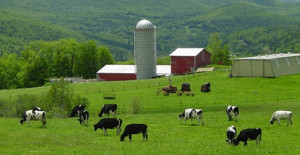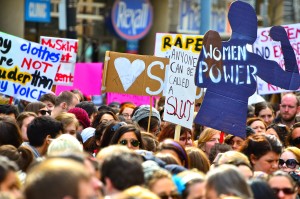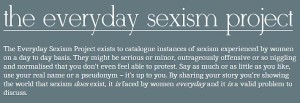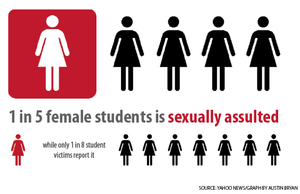
When most people think of where their food comes from, they probably think of a farm. This stereotypical farm image is generally what most people think of. People generally picture a big field with cows eating grass and a red barn. What nobody realizes though is that farms haven’t been like the image above in decades. The sad truth is that farms have become factories with the sole goal of creating cheap and sustainable food. However, it’s not the farmers that are in control of these farming practices, it’s big businesses.
These businesses have a lot more power than the average Joe thinks they do. Most of these large corporations have a strong hold on the average farmer. These large businesses often put farmers in crippling debt in order to silence those who are against current farming practices.
“You have to do it, or you’re threatened with loss of a contract. This is how they keep the farmers under control. It’s how they keep them spending money, going to the bank and borrowing more money. The debt keeps building. To have no say in your business, it’s degrading. It’s like being a slave to the company.” – Farmer in Food Inc.
Many of these businesses have large monopolies within the farming realm. With very few companies having such control over certain types of food, farmers have no choice but to succumb to whatever the company wants, or risk losing a contract and farming job entirely.
The food industry has an unfathomable amount of control over the consumer. As revealed in Food Inc., larger companies such as Tyson, give the consumer the illusion of more options by hiding behind smaller name brands. This means that even if you think you have a real say in what you’re eating, you might not.
But the corruption does not stop there.
Almost all of these large food production companies have members running for important positions in government. This leads to an ever present bias within government towards the food industry rather than public safety. These government positions allow for companies to have control over what safety precautions are made, which often benefits the food industry rather than the consumer.

It seems that as the food industry becomes larger and more profitable, food safety decreases. The problem according to Nestle is the government. There is not nearly enough regulations set in place by the government to protect the consumer. Nestle argues that many of these food borne illnesses could be prevented if the proper regulations were put in place. However, the main issue seems to be a lack in man power. The food industry has gotten much too large to be regulated by the limited federal government.
“By the early 1980’s, for example, the poultry industry had already expanded far beyond any reasonable inspection capacity.” – Nestle
While simply adding more regulations seems like the perfect solution, there seems to be many more underlying problems within the food industry.
Pesticides. Antibiotics. Animal Feed. These are just a few of the many problems within the food industry that wouldn’t be fixed with a few simple regulations.
But how do these problems effect you?
 Pesticides:
Pesticides:
So if pesticides are the problem, why don’t more people choose organic? After all, isn’t it true that organic farming uses less pesticides? This is the question many people seem to be asking. The problem with this statement is that the answer may not lie within the organic food industry. In a study done by Stanford University, it was found that organic foods did have less pesticides than conventional food. However, E. Coli was far more present in the organically grown food. It was also proven that organic foods aren’t really any healthier for you than conventional foods. In an article written by Blake Hurst, it was revealed that even the organic food industry is not entirely pesticide free. While the pesticides being used are not as strong, the organic farmer will often have to use more pesticides in order to make the less potent kind more successful. Hurst also argued that pesticides are necessary in farming. Without them, fields would need to be weeded by hand which takes up more time and requires more man power. So while the idea of not using pesticides sounds nice, it doesn’t seem to be entirely realistic. So if you’re trying to avoid pesticides entirely, you may be out of luck.

Antibiotics:
The reason why antibiotics are used in food production is not necessarily a bad one at first glance. The reason is to prevent sick animals from creating sick consumers after eating that animals’ product. When animals are kept in such tight quarters, it’s not uncommon for animals to carry bacteria. However, the more antibiotics are used in animals, the more antibiotic resistant bacteria are formed. This resistant form of bacteria contaminates the food that comes from that sick animal, which can then make the consumer develop an antibiotic resistant infection. The CDC says that the use of antibiotics in the food industry is ok. However, it should only be used to address sicknesses in animals, not to promote growth. However, even animals that are not sick get large doses of these antibiotics in order to create a bigger ‘super’ animal to create more food per animal. While this saves the food industry on costs, it only harms the consumers health in the long run.

Animal Feed:
What do you think a cow eats? Most people would say grass, right? Well the sad truth is that most cows and other animals no longer eat grass, they eat corn and other waste products. According to Consumer Reports these waste products are not limited to processed feathers, poultry litter, floor waste, feces, plastic pellets, and other forms of meat. As we know, cows and chickens are not carnivores and probably should not be eating feces from other animals. The reason why the food industry does this is because this type of ‘animal feed’ makes the animals fatter creating more food production per animal, which is then more profit for the food industry. This also creates less waste from the food industry since rather than throwing these things away, they feed them to the animals. The problem with this practice though, is that whatever the animal eats directly influences the consumer. In a study done by the Animal Protein Producers Industry, salmonella was found is about one fourth of feed on average. To simplify, if the cows are eating salmonella contaminated food, and then the consumer is eating it, there is a much higher likelihood that the consumer will then be contaminated as well.
So, why should any of this matter to the consumer [you]?
The consumer should have a say in how their food is being made. They should also be knowledgeable about what exactly the risks are to what they are eating. If the consumer is unaware of the practices being used in the food industry, how will they be able to fight it? They won’t.
The food industry needs a complete renovation. The government should not be biased towards companies using unsafe practices. While the lack of resources to monitor these farms is a valid excuse, it’s still not a good enough reason to put public health at risk. The people that make decisions on consumer health should be the consumer themselves, not the company or official getting a paycheck. The only people that should have a say in what a safe farming practice is, is the consumers, the FDA, and other food safety commissions. We as the consumer need to put a higher focus on food safety in order to protect ourselves and the rest of the nation.
A change needs to be made, and while change may take time it is definitely worth the wait to save even one life from dangerous food consumption. Food should not be made on a conveyer belt. Cows and other animals were meant to eat grass and be able to roam around. While these new techniques have made quite the profit for these big companies, the consumer is suffering greatly.
Consumer health needs to come before profit, and the only way to do that is to fight the industry for change. By voting for change in the food industry, we will once again put the power back in the hands of the everyday consumer [you].
Reflection Questions:
1.) The “writer’s project” seems to be whatever the writers main purpose is for writing an article. For example, in Blake Hurst’s article his “writer’s project” is to spread awareness about the real differences between organic and conventional farming methods while also exposing that conventional food isn’t necessarily bad for you. I was able to identify the texts project by summarizing the article and focusing on whatever the writers main argument was. My own “project” for this article was to spread awareness of the many dangers in the food industry and the many corruptions that prevent change being made. I also wanted to promote that consumers fight for a change within the food industry.
2.) The “Sorting it Out” workshop was actually really helpful. I ended up referring to it several times when drafting my article. I think the most helpful sections were summarizing each article and figuring out what it’s “project” was. It helped me remember which article was about what so I didn’t confuse the articles. The workshop also allowed me to start picking out quotes and connecting articles together so I could come up with one centralized idea for my article.
3.) Synthesis is taking information and simplifying it. It takes several different ideas or stories and combines them into one singular piece. It basically takes multiple perspectives and puts them together for a more rounded perspective. For my drafts I synthesized each piece and then used that to come up with my main argument.
4.) I learned how to create hyperlinks and write in a less formal tone.
5.) I originally began with the idea that the government was entirely to blame for the flaws within the food industry. However, later on I realized that perhaps the consumer is also to blame. After all, we’re the ones that vote these people into government roles. We should do our research to make sure these candidates have no biases. I attribute this revolution to the inclusion of more sources and also reading other peoples articles to get a better sense of what my opinion was on the topic.
6.) My organizational strategy was pretty simple. I broke it up the same way I would any other writing piece, just by topic. The only difference is that this article was much more casual and short so I broke it up into easier paragraphs. I just made sure to condense my topic as much as possible and shorten everything.
Example:
Original Draft:
These businesses have a lot more power than the average Joe thinks they do. Most of these large corporations have a strong hold on the average farmer. These large businesses often put farmers in crippling debt and force them to follow unsafe farming practices. With most of these businesses having a huge monopoly within the farming realm, most farmers have no choice but to succumb to whatever unsafe practices that company wants. Large companies such as Monsanto, have even gone as far as controlling what type of seed farmers use and how they use it. They use scare tactics to keep farmers from speaking out or breaking these unfair rules. But the corruption does not stop there.
Final Draft:
These businesses have a lot more power than the average Joe thinks they do. Most of these large corporations have a strong hold on the average farmer. These large businesses often put farmers in crippling debt in order to silence those who are against current farming practices.
I also added block quotes to the final draft to help make my point while also keeping the paragraphs simple.
7.) Example: It seems that as the food industry becomes larger and more profitable, food safety decreases. The problem according to Nestle is the government. There is not nearly enough regulations set in place by the government to protect the consumer. Nestle argues that many of these food borne illnesses could be prevented if the proper regulations were put in place. However, the main issue seems to be a lack in man power. The food industry has gotten much too large to be regulated by the limited federal government.
While I focussed on one particular article in this example, I think I did a good job touching base on the main argument in several other sources. My inclusion of the texts increased as I got further along in drafts and got closer to the final product.
8.) My ‘lede’ originally was really long, to be honest it didn’t even exist. I just started talking without hooking the reader in. The lede in my final draft forced the reader to imagine a stereotypical farm and then forced the reader to face the reality that farms don’t actually look like how they picture it.
Original ‘Lede’:
When most people think of where their food comes from, they probably think of a farm. Perhaps their farm has a happy farmer and his family making conscious decisions about the food they are making. The farmer would be the one in charge of how his food is created and what growing practices he/she chooses to follow. However, the sad reality is that the food industry is no longer controlled by the farmers themselves, they are controlled by big businesses.
Final ‘Lede’: When most people think of where their food comes from, they probably think of a farm. This stereotypical farm image is generally what most people think of. People generally picture a big field with cows eating grass and a red barn. What nobody realizes though is that farms haven’t been like the image above in decades. The sad truth is that farms have become factories with the sole goal of creating cheap and sustainable food. However, it’s not the farmers that are in control of these farming practices, it’s big businesses.
The feedback I got was to be more specific and make the reader picture what the farm looks like a little better. I originally was pretty vague and focussed more on the farmers than the farm itself.
9.) The next unit project I’d like to make more drafts. Maybe go to office hours to ask for better revisions. It felt like I had to make tons of revisions at the end for the final paper because I didn’t get enough feedback from my peers.









